You Dont Know Squat Nuritious Moement
This article, originally written June 2010 was updated and expanded a flake in Feb 2020 to include new resource and commentary. The do photos are still 10 years old though, and I recall I look similar a baby.
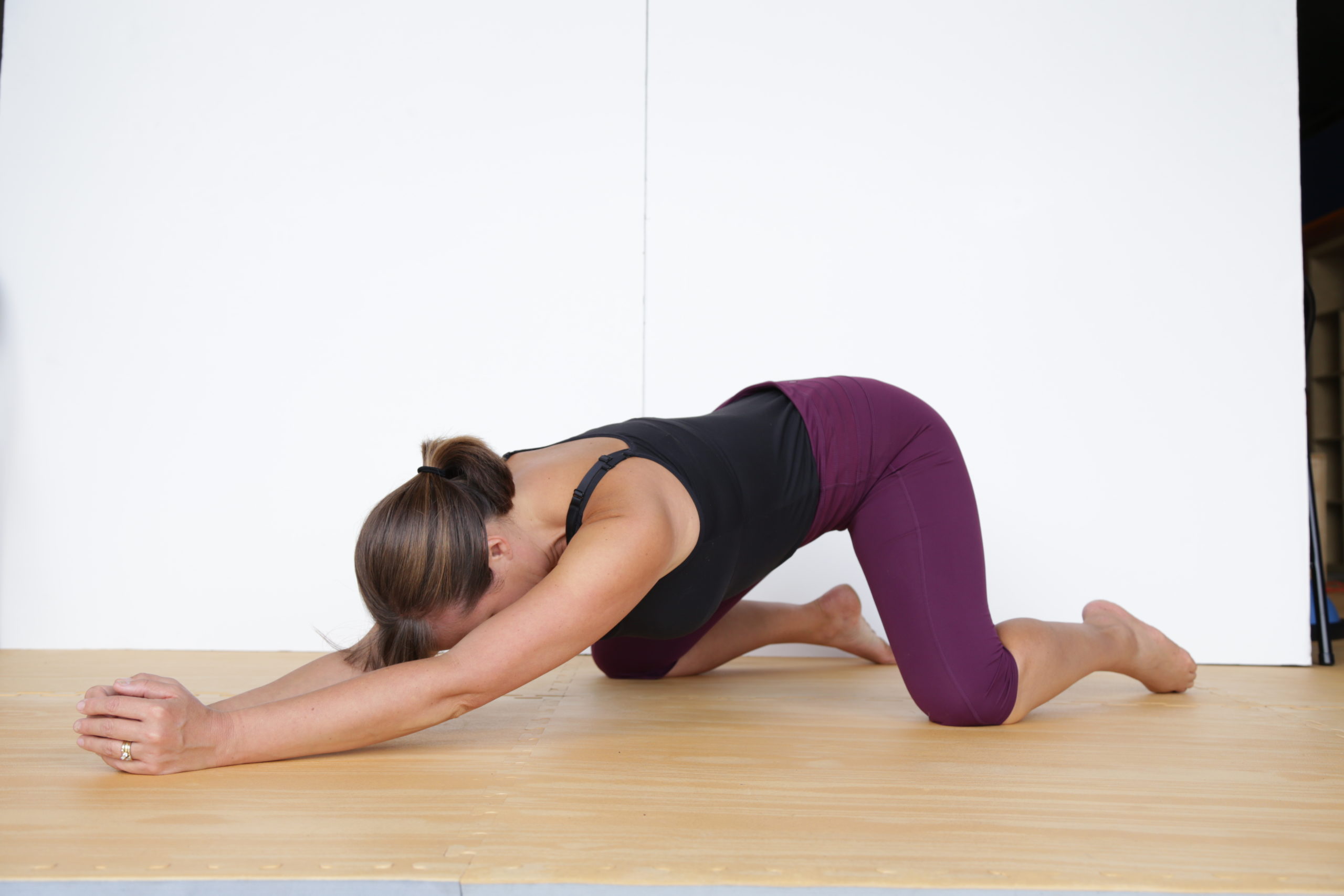
Are you ready, earth? In the side by side few years, yous are going to exist hearing more than and more about the health benefits of the squat. Just like the emerging barefoot movement I blogged about yesterday, the "squat movement" is going to happen in a large fashion, once everyone realizes that pelvic floor, hip, and knee wellness might actually depend on regular squatting (listen to this podcast episode on squatting).
If you haven't squatted in the final million years (too the two times you went camping and ended up peeing on your shoes), it can take a while to prepare your joints. Be patient, squat movements are worth it.
Two things:
1) Squats have many shapes and forms. Because of how much time our culture spends sitting and in heeled shoes, the ability to bend (flex) the hip and knees, and the power to bend (dorsiflex) at the ankle are usually an issue. These exercises are to assistance increase those movements.
2) Squatting is a neat movement that can increase your admission to many experiences, simply at that place are also benefits to the movements that comprise a squat. If, for whatever reason, you can't perform all the squat-elements at once, yous can still reap many benefits of a squat by working on your squat-parts.
To assist yous with your squatting movements, I've created a step-by-stride "preparing your trunk to squat" program you can begin right now. All you need is a yoga mat or thick towel or blanket.
If yous accept joint (knee or hip) replacements, stick to the first few lower-load "squat prep" exercises. Bogus joints range across the board, just many times this equipment is non designed to move with the same ranges of motility as intact joints. If you're trying to stay away from down pressures (in the case of a hernia or pelvic organ prolapse), spend time with the standing and quadruped moves earlier progressing to the upright squats. In either example, your wellness care team tin can advise you lot on sound progression.
In that location are many movements that make upwardly a squat; the exercises in this commodity are focused on increasing motion at the hip joint and the lower leg.
Squat Prep: Calf Stretch
Place 1 foot up on a rolled yoga mat (or towel or blanket), keeping your heel on the ground. Step forward with the opposite human foot to stretch the back calf, working to go along the stretching leg direct.
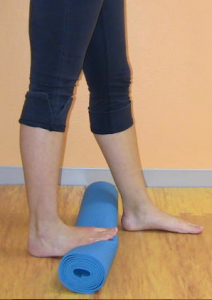
Squat Prep: Double Calf Stretch
Now footstep up with both anxiety and try to lift your tailbone until it looks less like this picture:
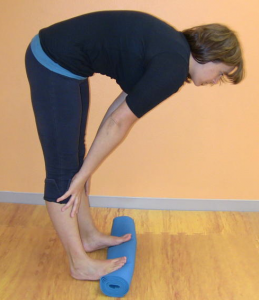
And more like this ane:
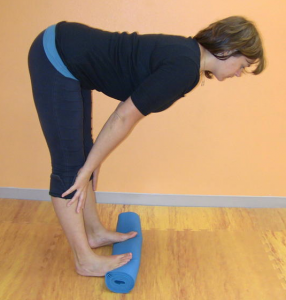
See the little curve at my low back? This indicates an untucked pelvis, and that your hamstring and calf length allow y'all to bend at the hips. If your tailbone slopes down, equally in the first moving picture, your too-tight hamstrings could be preventing natural pelvic flooring and glute strength from developing as you walk.
If you sit a lot, you tin hands spend 5-ten minutes running through the first two exercises every mean solar day. The Calf Stretch and Double Calf Stretch are smashing for preparing your joints for full flexion (angle all the style).
After y'all've warmed up the back of the calves and hamstrings with a little stretching, it's time to get downward onto your hands and knees, with your knees a little wider than your pelvis. If you lot cannot become onto your hands and knees on the floor, try out this series on your bed.
Lower-leg alignment
When on your knees, check that your lower legs and feet track straight back, and are parallel to each other. If your ankles come together or your feet point in toward each other, straighten those parts.
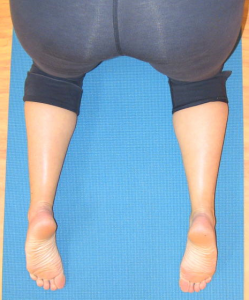
From the hands-and-knees position, drop the hips back equally far as you can, without allowing the feet to move closer to each other or assuasive the tailbone to tuck under.
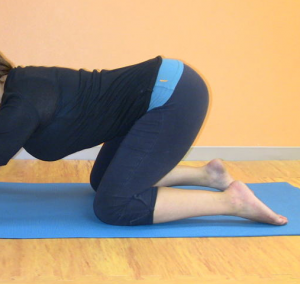
In the picture beneath, see how I went also far! My pelvis tucked and instead of bending at the hips, I'thou now bending at the spine. If y'all're using squats to better the strength of your backside, then the longer you tin can continue your pelvis untucked the better. If your hips are far from your heels, and y'all're already tucking, come forward, re-lift your bum, and hang out, going but every bit far back every bit y'all tin can staying untucked. Practice this a few times a twenty-four hours until you tin can deepen your untucked sit-back.
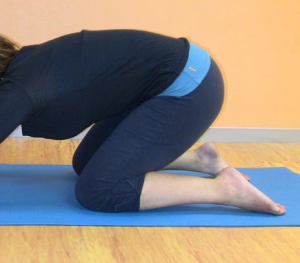
Yous may as well see how the torso is starting to look similar information technology'south in a deeper squat, just this squat is without the loads. I have found information technology's amend to improve the range of move of your squat parts earlier adding all your torso weight onto tight joints.
Soleus Stretch
Once your knees and hips are more used to flexing, you can start moving your anxiety into their (unloaded) squatting position. Tuck your toes under and watch that your heels don't drop towards each other.
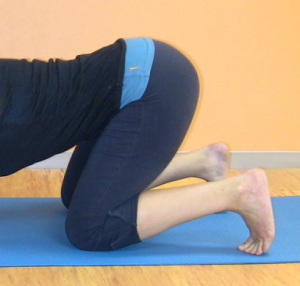
Spend some time stretching your feet while sitting back (aaaaand lifting your tailbone!).
Increasing your squat loads
Now it'southward time to kickoff bearing your body weight. The strength needed in a squat is non but in the getting downward and back up; you also need strength in the lower legs, as your body weight is being controlled at the ankles. I detect information technology'southward frequently the lower leg muscles that fatigue first!
To keep squats safer for your knees and hips, work on maintaining the alignment of the lower leg and feet. For these squats, the anxiety are positioned simply wider than the pelvis, anxiety forrard (you tin align them to your thighs), and the knees should not be wider or more than narrow than the feet.
When you first squat, super tight quads and psoai can increase the pressure in the knees. In addition to regularly working those squat-prep exercises to a higher place, decrease that tension and give yourself boosted joint space past placing the rolled yoga mat backside the knees.
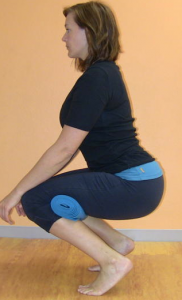
Attempt to both untuck the pelvis besides as lower the heels toward the footing. Hold onto something when yous first outset, if you're feeling wobbly!
Use a mirror
Attempt this in front of a mirror to bank check that your anxiety and knees are however aligned well,
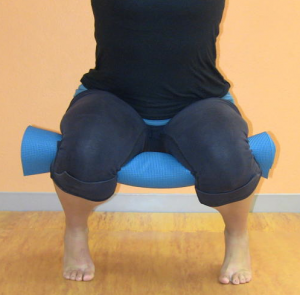
and they haven't twisted (see how my correct thigh and foot poke out?) and your weight hasn't shifted to favor i side. If you are doing this, you might have to decrease the depth of your squat (see at what depth you're losing your alignment; this lets you know from where to work).
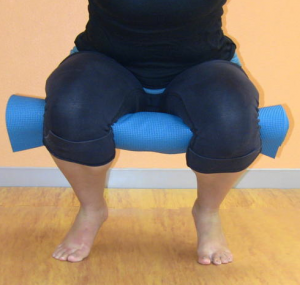
After the ankles and lower legs have had a chance to stretch and strengthen, prop your feet up with the rolled yoga mat to give them a break. One time you're not pulling and then much on your lower legs, y'all will probable find your knees can bend closer their full range. Always check that you're working to motility your pelvis into an untucked position (even if it doesn't go anywhere).
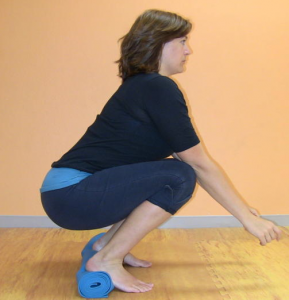
Can y'all move between tucked and untucked?
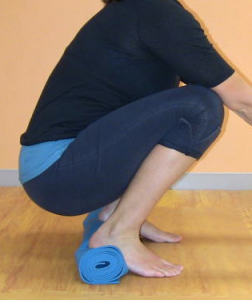
Somewhen you will be able to deepen your hip flexion and and get your heels closer to the ground. Or maybe y'all won't, simply still you'll exist moving parts that often go unmoved. Utilise this program as a leg and good for you pelvis workout. Progress through these exercises as you feel comfortable, giving yourself plenty of time (which can mean weeks, months, or years) to strengthen your body.
Want more than squatting exercises? Read You (Still) Don't Know Squat and bank check out my 2017 squat-themed exercise appearance for 24 squat moves. Read Our Best "Salubrious Pelvis" Resources for more on pelvic floor health.Read Move Your DNA for more than information on squatting and natural movement. If you like to heed to learn, Podcast Episode #91 is all about the squat. If y'all're wanting more than simple exercises to make your hips, pelvis, and lower back more supple, bank check out Nutritious Motion for a Healthy Pelvis.
Source: https://www.nutritiousmovement.com/you-dont-know-squat/
0 Response to "You Dont Know Squat Nuritious Moement"
Post a Comment